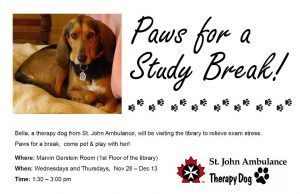Learn about the benefits of constructing a multi-year internship from a MLIS student's perspective.

Paws for a Study Break
Therapy animal programs (also known as Animal-assisted therapy or AAT) are commonly used in hospital and rehabilitation settings, where they “have a way of improving moral and can act as a motivator for therapy, treatments, and recovery.”
Somewhere along the line, people realized that therapy dogs are not only beneficial for those undergoing physical rehabilitation, but also provide relief to those suffering from mental illness, or even just temporary stress and angst.
According to the Spring 2013 National College Health Assessment in Canada, over 50% of students reported feeling “exhausted”, “lonely”, “sad” and/or “overwhelming anxiety,” and 89% reported that they “felt overwhelmed by all [they] had to do” at some point in the previous 12 months.
Many post-secondary institutions have started to implement therapy dog visitor programs for students through student unions, departments and faculties, and also in campus libraries. The Gerstein Science Information Centre is a locus of student studying on the University of Toronto St. George campus, with space for 1100 students. I wanted to find a way to provide a few moments of relief for the hundreds of students who congregate at Gerstein during the most stressful times of the year—Spring and Fall exams.
When setting up a Therapy Animal program in the library, there are several factors that need to be considered.
Working with the volunteer agency
For our visits I contacted the St. John Ambulance Therapy Dog program with a description of what we were hoping to achieve. They then put a call out to their members to see if anyone would be willing to bring their dog to our particular address. Given that we are located in the core of Toronto, and our matched volunteer was from the outskirts, we offered to pay for mileage and parking fees. Before scheduling the visits we arranged for some introductory meetings, to ensure that the dog and handler were comfortable in the library setting, and were a good fit for us.
Location of the visits in the library
We wanted Bella, our doggie visitor, to be visible and easily accessible to students wishing to participate, but we also did not want to disturb students who weren’t interested, or potentially afraid or allergic. We decided to host the visits in one of our study rooms, just off the main Reading Room, with a glass door so that even with the door closed, visitors could see that Bella was there and available for a visit.
Publicity and media

We publicized the event on campus through posters, social media, announcements on our flatscreen library displays; and we also had our Communications librarian send out a publicity statement to local media outlets. This resulted in several requests for interviews, as well as requests to take photos and videos of Bella interacting with the students. We were excited to be getting the publicity and so agreed to all media requests.
However, in hindsight, media requests for photos, filming, and interviews should be considered thoughtfully before agreeing to participate. Though the media coverage helpfully spread the word to the wider community, it was also found to be disruptive for the students and the volunteers to have a camera around.
My recommendations are to set strict limits
for filming and/or photography.
Allow filming or photography for a limited time only (10-20 mins max) during the session, and have interviews taped away from the therapy dog location so that students can still enjoy the dog while filming is going on.
Evaluation
We had paper evaluation forms in the room which students were encouraged to fill out. The same form was also created online using SurveyMonkey and bookmarks with the survey address were placed in the room for students to take away with them. A staff member was present at all times, and recorded the number of students who came in for a visit.
Through a total of 6 visits of 90 minutes each, 417 visitors came to interact with Bella. Of those that completed the evaluation form, 82% rated the event as Excellent and 100% indicated they would be interested in attending a similar event in the future.
Staff were equally smitten by the experience and we had a number volunteer to “supervise” subsequent visits by Bella. Based on this, “Paws for a Study Break” visits were repeated during both Spring and Winter exams in 2013, and we are planning to continue this program during exam periods on an ongoing basis!
For more information about setting up and running a Therapy Dog program in the library, please see my full article in Partnership.
Allison Bell is the Manager, Research & Reference Unit at the Gerstein Science Information Centre, University of Toronto. Having grown up with a dog, cat and rabbit, she knows first-hand the comfort a warm furry pet can give during stressful times, and wanted to share these benefits with stressed out students and staff. She is currently on maternity leave, but her excellent colleagues at Gerstein are keeping the Therapy Dog program going in her absence. Allison can be reached at allison.bell [at] utoronto.ca or tweet to her @bellalli.


